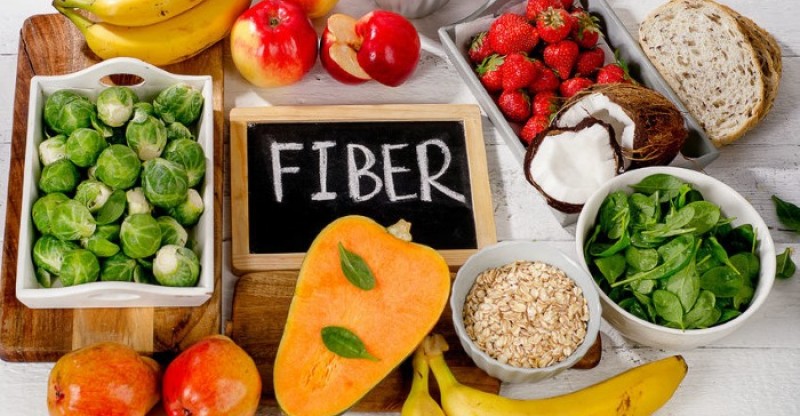Fiber… you’ve probably heard that you should be eating more of it. If you’re like millions of Americans, it’s likely true.
Fiber has many, many health benefits, including lowering cholesterol, controlling blood sugar levels, helping us achieve a healthy weight, normalizing bowel movements and maintaining bowel health. Fiber also reduces the rate of intestinal carbohydrate absorption, reducing insulin response.
Fiber is a type of carbohydrate that we cannot digest because we lack the digestive enzymes required to break it down. Fiber slows down the digestion and absorption of nutrients, resulting in a prolonged feeling of fullness and reduced appetite. This may reduce food intake and lead to weight loss.
Women need 25 grams of fiber per day and men need 38 grams per day, according to the Institute of Medicine. Yet, only 5 percent of people in the US meet that recommended target. The average adult eats just 15 grams of fiber per day, which is about half of what we should be getting. Everyone would benefit from adding more fiber to each meal.
There are different types of fiber and each is uniquely different. Fiber is either soluble or insoluble, viscous or non-viscous and fermentable or non-fermentable.
Soluble fiber dissolves in water; insoluble fiber does not. Viscose fiber is gel-forming. Fermentable fiber can be metabolized by gut bacteria. And some fibers are combinations of all three. So, not all fiber is created equally; the various types of fiber have different properties in the gut.
Insoluble fiber or “roughage” goes through your system unaffected by the digestive process. When mixed with water, insoluble fiber acts like a sponge, absorbing liquid and swelling in size in the gastrointestinal tract.
Soluble fiber dissolves in water and is often viscous, meaning it forms a gel in your gut. Soluble fiber is found in such foods as oatmeal, flaxseed, beans, peas, Brussels sprouts, apples, pears, citrus fruits, carrots, barley and psyllium. One serving of a breakfast cereal with oatmeal or oat bran provides 3 to 4 grams of fiber. If you add fruit, such as a banana or berries, you’ll get even more fiber.
Soluble fiber can reduce the absorption of cholesterol into your bloodstream. Five to 10 grams or more of soluble fiber a day decreases your LDL (bad) cholesterol. How does it work?
Soluble fiber binds to bile salts in the gastrointestinal tract, causing them to be excreted as part of our fecal matter, rather than being re-absorbed by the colon, as they usually are. Since blood cholesterol is needed to make bile, the body must pull more cholesterol out of our blood to make more bile to replace what was lost. This ultimately lowers the amount of cholesterol in our bloodstream.
Eating high-fiber foods is also critical to our gut health, which determines our overall health. High-fiber foods feed the healthy bacteria that improve immune function, reduce inflammation and chronic disease, and even help regulate mood.
When we don’t consume enough fiber, we are essentially starving our gut microbiome, the ecology of trillions of diverse bacteria lining our intestines and colon. Fiber nourishes our gut microbiome.
There are an estimated 100 trillion bacteria residing in the human gut, mainly in the large intestine (aka, colon). The key is to increase the number of good or healthy bacteria. Both soluble and insoluble fibers undergo fermentation in the large intestine, which stimulates the production of good bacteria there.
Consequently, fermentable fibers also stimulate the immune system, inhibit inflammation, stabilize blood glucose, and suppress LDL cholesterol and triglycerides.
Foods that are rich in fermentable fibers include beans, legumes, oats and barley, as well as fruits and vegetables.
Fiber doesn’t just help us poop better. Its ability to fight constipation misses the big picture; daily bowel movements and bowel health are not the same. Providing regularity is just one of fiber’s many benefits, and it is not as important as fiber’s impact on our microbiome.
The best way to meet your daily fiber requirement is to eat a wide variety of whole foods, rather than supplements, and to minimize processed foods. Focus on eating more fruits, vegetables, whole grains, beans, lentils, nuts and seeds.
With low-carb diets (i.e., the ketogenic plan, the Atkins diet and the paleo diet) becoming increasingly popular, adherents of these plans are usually getting insufficient fiber.
Americans who think going “low-carb” simply means eating more meat often end up eating less vegetables, fruits and grains. Since the latter reduce inflammation, cutting them out can increase inflammation, which has been linked with a variety diseases, including heart disease and stroke, and may also lead to autoimmune disorders, such as rheumatoid arthritis and lupus.
If you eat a wide variety of whole, plant-based foods every day, and are sure to have some with each meal, you will likely meet your daily fiber requirement. Include veggies in every meal and be sure to eat them first, such as a salad before your meal. This will help you to fill up on very low calorie, high fiber foods before anything else.
Any food that contains 2.5 grams of fiber per serving is considered a good source, and 5 grams or more is excellent.
Chia, flax, sesame and hemp seeds are all great sources of fiber. They can be added to to oatmeal, yogurt and smoothies, for example.
One cup of cooked beans can deliver up to 75% of your daily fiber needs. Beans are also packed with protein, vitamins and minerals.
Raspberries and blackberries have 8 grams of fiber per cup.
Avocados are incredibly nutritious fruits and half an avocado delivers 5 grams of fiber.
One small pear has 5 grams of fiber and apples are also packed with fiber.
However, if you peel fruits and vegetables, you’ll often remove half the fiber. So, leave the skin on apples, cucumbers and sweet Potatoes, etc.
By meeting your daily fiber requirement, you’ll achieve a whole series of health benefits, which will pay dividends now and in the future.






